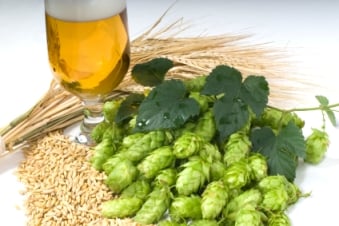This week I take a look at one of Germany’s most popular beer styles, the light lager known as German Helles.
Helles is a traditional German Lager produced primarily in Southern Germany (Bavaria) around Munich. The word “hell” in German can be roughly translated as “pale, light or bright” in English.
The History of Helles
Helles made its first appearance around Munich in 1894. It was the Bavarian response to the surge in popularity of light Czech Pilsner. Bavarian brewers had traditionally made strong, dark lagers but the appearance of crisp golden Czech pilsners forced them to brew a lighter lager.
Bavarian brewers of course put their own spin on the style, and rather than duplicating the Czech pilsner, they created their own distinctive lager that is maltier and breadier. While it still retains the crispness of a lager, it lacks the spicy hops of a Czech pilsner and instead tilts to the malty side, but still in a light, extremely drinkable beer.
The Helles Beer Style
The BJCP Style guide describes Helles as a “A clean, malty, gold-colored German lager with a smooth grainy-sweet malty flavor and a soft, dry finish.” While there may be a subtle spicy or floral hop aroma, the bitterness is still tilted to the malty side though not overly sweet. The beer should finish soft and dry.
The beer is roughly 4.7-5.4% ABV, with original gravity in the 1.044-1.048 range, and bitterness between 16 and 22 IBUs. Like many Bavarian lagers it has a slightly higher carbonation level (2.5 vols+) to support a creamy white head.
Brewing a Munich Helles
The base of a good Munich Helles is continental pilsner malt. Choosing a good German pilsner malt base is important as this forms the foundation for this style. Many commercial examples are made with 100% pilsner malt.
If you wish to add additional malts, typically Munich or Vienna malts are used to provide a bit more malty depth. However, I would recommend using 10% or less of these malts as too much will spoil the balance of the beer.
Some brewers also use a small amount (a few percent) of Melanoidin malt to try to replicate the malty finish that comes from doing a long traditional German decoction mash. However, some claim this is really can’t replace the traditional mash.
I would use a traditional German hop with this beer style such as Tettnang, Spalter or Hallertauer. You want to avoid the spicier noble hops such as Saaz as a spicy finish is really not appropriate. Add enough hops to balance the malt (16-22 IBUs) but no more.
As far as mashing, you do have a few options here. One option is to do a full traditional multi-step decoction mash. This will most likely get you a nice malty finish on the beer and close to the traditional style. However it is painful as it is messy and takes several hours.
Another option is to do a hi-low (often called barbell or lager) mash. This is the approach Gordon Strong advocated in a recent podcast. (I recommend listening to it if you have the time) This involves doing your first mash step at low temperature – perhaps around 147 F (64 C) and then doing a second mash temperature at higher temperature of perhaps 156 F (69 C). The combination results in slightly higher attenuation giving a cleaner finish without sacrificing the malty finish. This would be my recommendation for this style.
Fermentation and finishing is important as any flaws will show up in this sbeer. You want to pitch a traditional German Helles lager strain in sufficient quantity to get a strong fermentation going up front. Temperature control is critical, as you really can’t “fake” this particular style by fermenting at high temperature. Ferment at the recommended yeast temperature range (typically around 50 F/10 C) and do a diacetyl rest after fermentation is complete by raising the temperature several degrees and holding for a day.
For a completely clean finish the lager may require some cold aging – cold crash if possible and lager the beer until the off flavors are cleaned up. Carbonate to a healthy level (2.5-3 volumes) and pour slowly.
You can find some great Helles recipes on the BeerSmithRecipes.com web site. Use traditional German pilsner malt and hops if possible, do a two step lager mash, and manage your fermentation carefully and you will enjoy a great beer.
I hope you enjoyed this week’s article from the BeerSmith Home Brewing Blog. Please subscribe for regular weekly delivery, and don’t hesitate to leave a comment or send this article to a friend.
Related Beer Brewing Articles from BeerSmith:
- Pilsner Lager Recipes – Beer Styles
- Brewing The Dunkles Bock Beer Style
- Base Malts in Beer Brewing
- Beer Design Case Study: Marzen
- Bock and Doppelbock Beer Recipes – Beer Styles
- Brewing Marzen and Oktoberfest Beer Recipes
- German Rauchbier and Smoked Beer Recipes
- The Rise of Craft Beer Lagers
Don't make another bad batch of beer! Give BeerSmith a try - you'll brew your best beer ever.
Download a free 21 day trial of BeerSmith now




{ 0 comments… add one now }